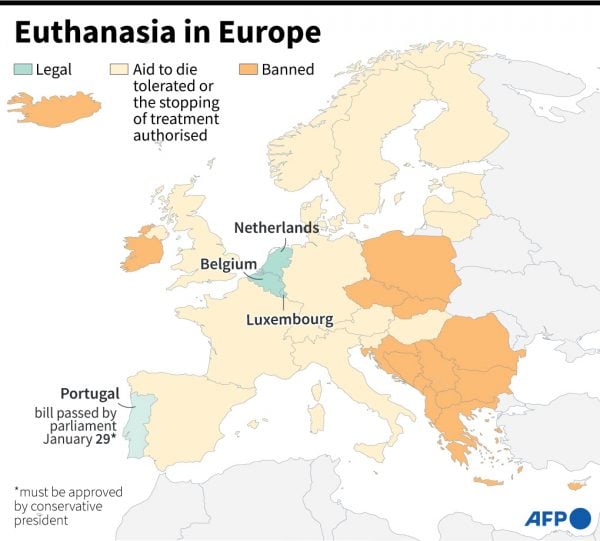PARIS: Twenty years ago, on April 1, 2002, the Netherlands became the first country in the world to legalise euthanasia.
Since then, in Europe, only three countries have followed suit but several others have passed laws making it easier for people who are suffering to end their lives.
The concept of helping people to die remains highly controversial in deeply Catholic countries like Poland and Ireland.
Here is a round-up of the situation in Europe.
Fully legal: Dutch lead the way
In 2002, the Netherlands legalised active euthanasia, whereby doctors administer lethal doses of drugs, to patients experiencing unbearable suffering from a condition diagnosed as incurable by at least two doctors. The law stipulated that the patients had to be lucid.
In 2020, the country’s highest court ruled that doctors could carry out euthanasia on patients with severe dementia without fear of prosecution, even if the patient no longer expressed an explicit wish to die.
The Netherlands was also the first in the world to authorise euthanasia for over 12s and has also moved towards making it legal for terminally ill children aged between one and 12.
Belgium, Luxembourg, Spain follow
Belgium was hot on its heels, lifting restrictions on euthanasia in May 2002 for patients facing constant, unbearable and untreatable physical or psychological suffering.
They must be aged 18 or over and request termination of life in a voluntary, reasoned and repeated manner, free from coercion.
In 2014, Belgium became the first country to authorise children to request euthanasia if they suffer a terminal disease and understand the consequences of the act.
In neighbouring Luxembourg, a text legalising euthanasia in certain cases of terminal illness was approved in 2009. It excludes minors.
Spain joined the group in June last year, with a euthanasia law allowing the terminally ill or gravely injured to end their suffering under strict conditions.

Assisted suicide
Switzerland allows what is called “assisted suicide”, under which patients administer a lethal dose of medication themselves.
It does not allow active euthanasia by a third party but tolerates the provision of substances to relieve suffering, even if death is a consequence.
In Austria, legislation approving assisted suicide took effect on January 1, 2022. It came after its constitutional court ruled the country was violating fundamental rights in making it illegal.
Italy’s constitutional court in February shot down a bid to hold a referendum on decriminalising assisted suicide, judging that such a vote would fail to protect the weakest.
In 2019, the court had ruled that it should not always be punishable to help someone with “intolerable” physical or psychological suffering to commit suicide.
In Portugal, President Marcelo Rebelo de Sousa last year vetoed a bill which would have legalised access to assisted suicide for adult patients in a situation of “extreme suffering and irreversible damage”.
‘Right to die’
In France, a 2005 law legalised passive euthanasia, under which a patient is taken off life support, as a “right to die”.
A 2016 law allows doctors to couple this with “deep and continuous sedation” for terminally ill patients, while keeping euthanasia and assisted suicide illegal up to now.
A bill on “free and chosen” euthanasia for incurably ill patients in France’s lower house failed to get through in April 2021.
Britain has allowed medical personnel to halt life-preserving treatment in certain cases since 2002. Prosecution of those who have helped close relatives to die after they have clearly expressed the desire to end their lives has receded since 2010.
Denmark has allowed people to file written refusal of excessive treatment in dire situations since 1992, with the document held in a centralised register.
Passive euthanasia is also allowed under certain conditions in Germany, Hungary, Latvia, Lithuania, Norway and Sweden.

ADVERTISEMENT
ADVERTISEMENT


































